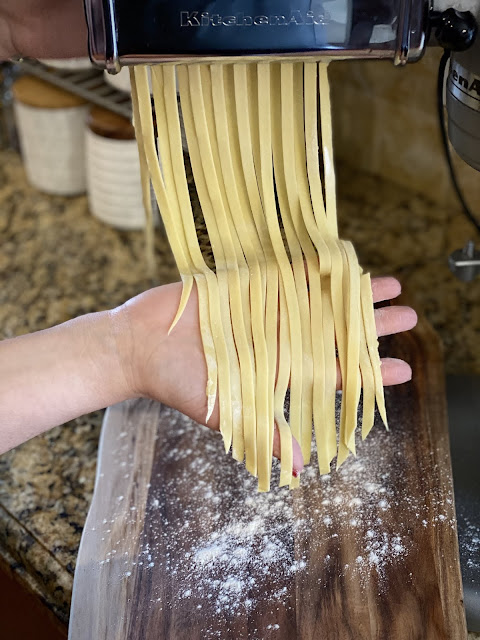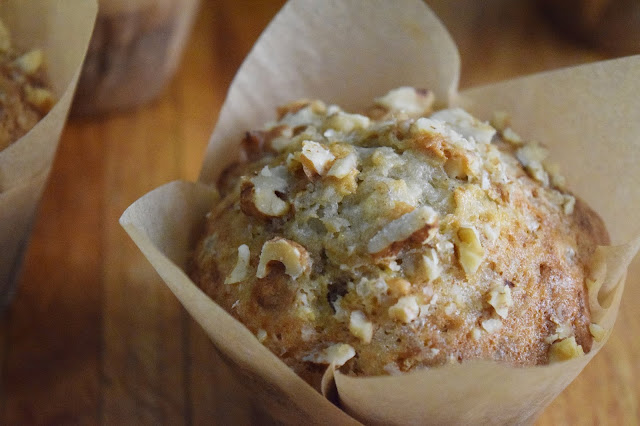a recipe for pasta dough, pasta sheets and classic fettuccini
I love Italian food. I love pasta... A refrigerator full of water and Gatorade? Honey, that's just not gonna happen.
-Queen Latifah
Italian's eat, breathe and live pasta. There are individual exceptions, as with anything, but culturally it is a big freaking thing. And the wildest part of the country-wide fixation is that traditional pasta isn't the main part of your meal, but rather just the "Primi" (aka. first course). It's just one course followed by breads and meats and vegetables and salads and I honestly have no idea how people do it. We'll go all-out with the multiple courses during the holidays and by the end of it all I basically have to be rolled out of the door of my Nonna's place. So... much... food...
Obviously, my issue here revolves around portion-control. I can't just have a teensy bit of pasta and then move on to the next course. Gosh, no. I need all the pasta. I love it so much that it can't be anything so diminutive as just one part of a meal for me. When I'm eating pasta, it's my whole freaking world. And if something is going to be your whole world, you better make it worth it, you know? I'll eat dried pasta and I'll love every bite, but for something special... for a meal that's really worth it... fresh pasta.
And so I have for you a recipe for the multiple evolutionary stages of fresh pasta. This recipe details how to make the dough itself, how to roll it out into pasta sheets, and, finally, how to cut it out into fettuccini. Wanna make lasagna, cannelloni, manicotti, ravioli, tortellini, spaghetti, fettuccini and angel hair? It all starts here, people, and it's super dooper easy. Once you have a good recipe for pasta dough, the world of delicious, endlessly-customizable fresh pasta is within your grasp. Sure, you can buy it fresh from Italian grocery stores and it'll be great. But it'll also be around $22/kg. Or you can make it yourself in under an hour for around $2, learn an awesome new skill, master a new recipe category and impress everyone in your life. Imagine the pastabilities. *Nudge Nudge*
*Note: You can still make fresh pasta if you don't have a pasta machine with which to roll it out (simply divide the dough into 6 balls, roll each out as thin as possible and cut into 1 cm-thick strips, alla fettuccini), but a pasta machine does, of course, make the process easier. They're pretty affordable and they'll basically last forever, which makes a pasta machine a good investment if you're willing to give the process a shot (you can grab a basic model on amazon right now for $50 with 2 week shipping). Good luck!
pasta dough, pasta sheets and classic fettuccini
Makes: 1.5 lbs fresh pasta Serves: 4-6 people Total time: 50 mins
Ingredients:
- 2 cups all-purpose flour, plus more for dusting
- 1 tsp salt
- 3 extra-large eggs
- 2 tbsp extra-virgin olive oil, divided
Directions
For the dough:1. Combine the flour and salt in the bowl of a stand mixer. Form the dry ingredients into a mound, then hollow out a crater in the centre of the mixture. Crack the eggs into the crater and drizzle in 1 tbsp of the olive oil. Using a fork, beat the eggs and olive oil together, incorporating the surrounding flour into the dough a bit at a time until it gets too thick/awkward to mix with a fork. At this point, use your hands to knead the dough together with the remaining flour until the majority of the dry ingredients have been incorporated, approximately 2-3 minutes. Fit the bowl into the stand mixer, fit it with a dough hook* attachment and set the machine to knead on medium speed until the dough is elastic and smooth, approximately 7 minutes.
*Note: If you don't have an electric mixer, combine the flour and salt on a large, available work surface, such as a cutting board or cleared countertop. Form the dry ingredients into a mound, hollow out a crater in the centre and crack the eggs into it. Drizzle in 1 tbsp of the olive oil and beat the wet ingredients together with a fork. Gradually incorporate the surrounding flour from the inside wall of the mound until the dough gets too thick/awkward to continue mixing with a fork. Using your hands, knead the dough together with the surrounding flour until the dry ingredients have all been incorporated. Work the dough, folding and kneading firmly, until it becomes elastic and smooth (approximately 10 minutes), sprinkling a bit of flour on your work surface when necessary. Don't add too much additional flour, however, as it can make the dough dry and tough.
 |
Measuring out the wet ingredients and adding them to the crater in the dry ingredients
|
 |
Beating the wet ingredients with a fork and incorporating flour in the process
|
 |
Time to start mixing by hand
|
 |
Dough is ready to be put in the stand mixer at this point
|
 |
Dough is smooth and elastic dough after kneading in the stand mixer
|
2. Test the kneaded dough to see if it's the proper consistency. As flour tends to absorb moisture in the air, your dough can vary in consistency based on the time of year and current weather conditions. Your ideal pasta dough has a texture similar to that of kneaded clay (soft, elastic and pliable, but not sticking to your hands or cracking when you stretch it out). If the dough is too soft/sticky, dust the dough with a bit of flour and knead until it's all been incorporated. Test the consistency again and repeat if necessary. If the dough is too tough and is cracking when you stretch it out, simply wet your hands with a bit of running water and knead until it's all been incorporated. Test the consistency again and repeat if necessary.
3. Divide the completed dough into two pieces and form into balls. Brush the surfaces of the dough with the remaining tbsp of olive oil and wrap tightly in plastic wrap to keep them from drying out. Set the balls of dough aside for 30 minutes to allow the gluten to relax.
For the pasta sheets:
4. Remove the plastic wrap from one of the balls of dough, form into a 1cm-thick rectangle and dust with a bit of flour.
5. Set a pasta machine at its thickest setting (setting 1 on the dial) and slowly run the dough vertically through the smooth roller attachment to begin the process of thinning out the dough. The smoothest way to run dough through a pasta machine is to feed the dough into the machine with one hand and gently catch it with the other as it comes out the end. Attempt to keep the speed steady throughout the rolling process, otherwise the motion of the machine starting and stopping will dent the sheets a bit.
*Note: If the dough tears at any point during this process, it's because it was too thick to smoothly fit through the machine. Simply form the dough back into ball, flatten it out into a 1 cm-thin disk and try again.
6. Fold the rolled-out dough it in half length-wise and stretch it out a bit with your hands and run the pasta through the machine's thickest setting again. Repeat this 1-2 more times to warm up and stretch out the dough a bit before moving onto the next stage.
7. Tighten the machine to it's second-thickest setting (setting 2 on the dial) and run the dough through, feeding it into the machine with one hand until the roller catches the dough and then switching to receive it with your other hand as it comes out of the other end.
8. Tighten the machine to it's third-thickest setting (setting 3 on the dial) and run the dough through again, feeding it into the machine with one hand until the roller catches the dough and then switching to receive it with your other hand as it comes out of the other end.
9. Continue to run the pasta through the machine on progressively-thinner settings until you've reached a suitable thinness for what you plan on using the pasta sheets for. Generally:
- setting 4 or 5: standard pastas (lasagna sheets, cannelloni, spaghetti, fettuccini, etc.)
- setting 6 or 7: thin pastas (thin fettuccini, thin spaghetti, etc.)
- setting 7 or 8: very thin pasta (angel hair, spaghettini, etc.)or pastas that require two layers stuck together (tortellini, ravioli, etc.)
10. Dust the sheets of dough with flour and lay out on a flat surface while you repeat the rolling out process with the other dough ball.
For the fettuccini:
1. Cut the floured dough sheets, which have been rolled out to the 4 or 5 setting on your pasta machine, into 2-3 shorter pieces based on your personal preference.
2. Exchange the smooth roller attachment for the fettuccini cutter on your pasta machine.
3. Run the pasta through the pasta machine, feeding it into the machine with one hand until the roller catches the dough and then switching to receive it with your other hand as it comes out of the other end. You now have fresh fettuccini,- hooray!
4. Separate the pasta pieces as best you can and dust them liberally with flour to prevent the pieces from sticking together.
*Note: The pasta will keep well in the refrigerator for 3 days or in the freezer for up to 3 months.


















